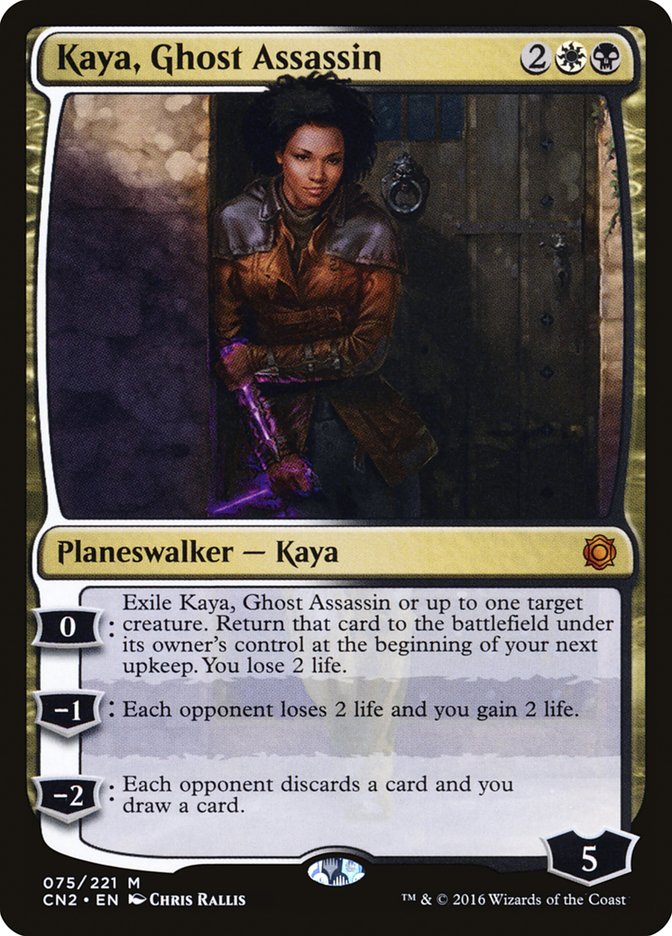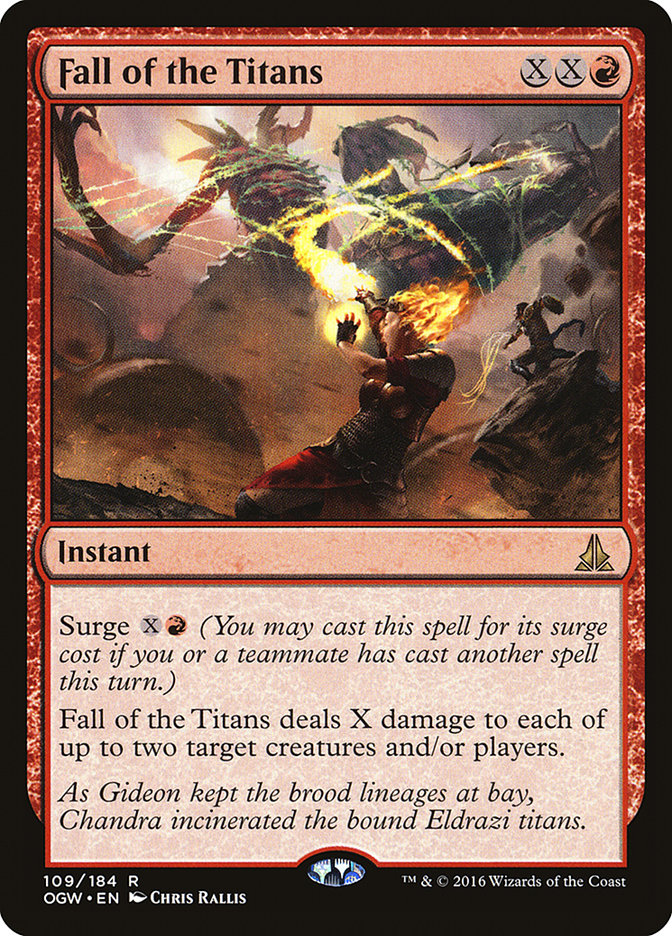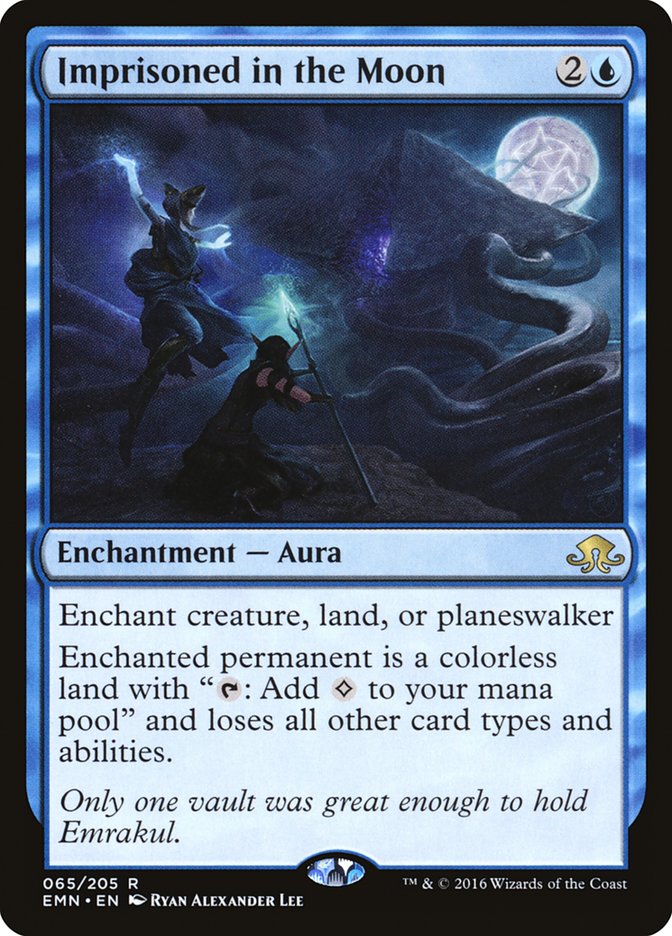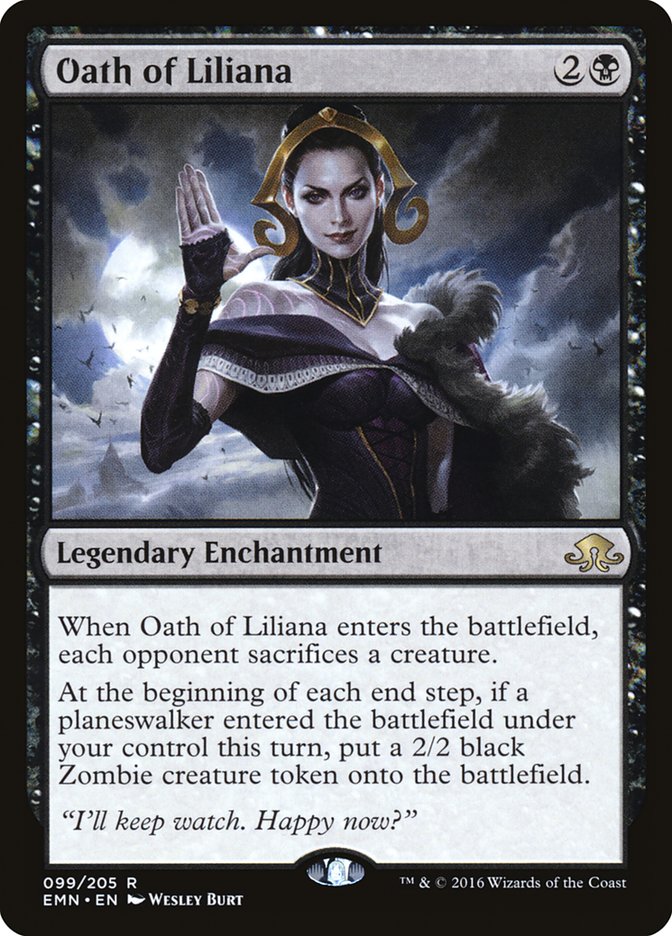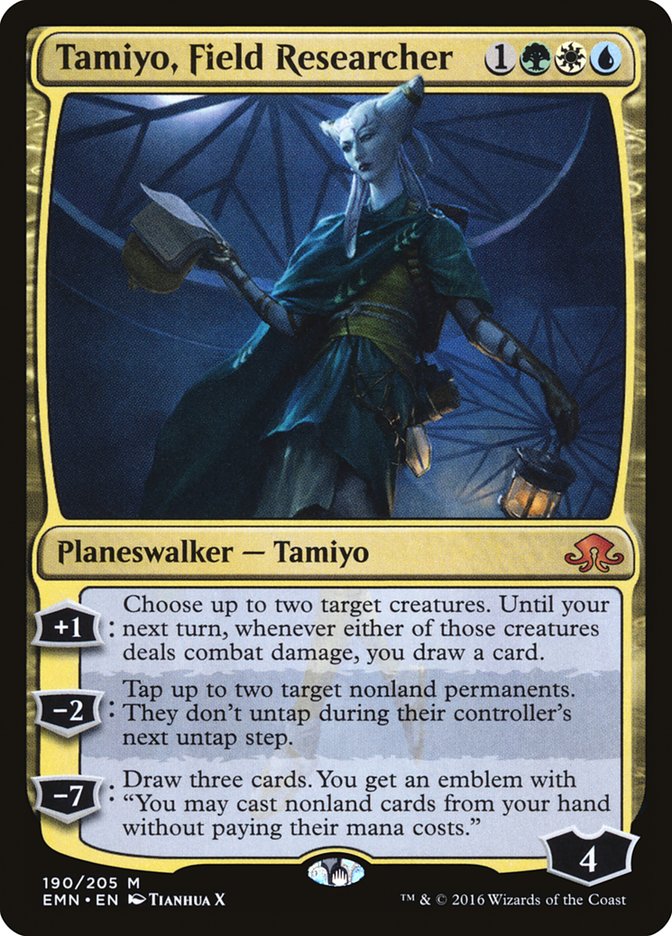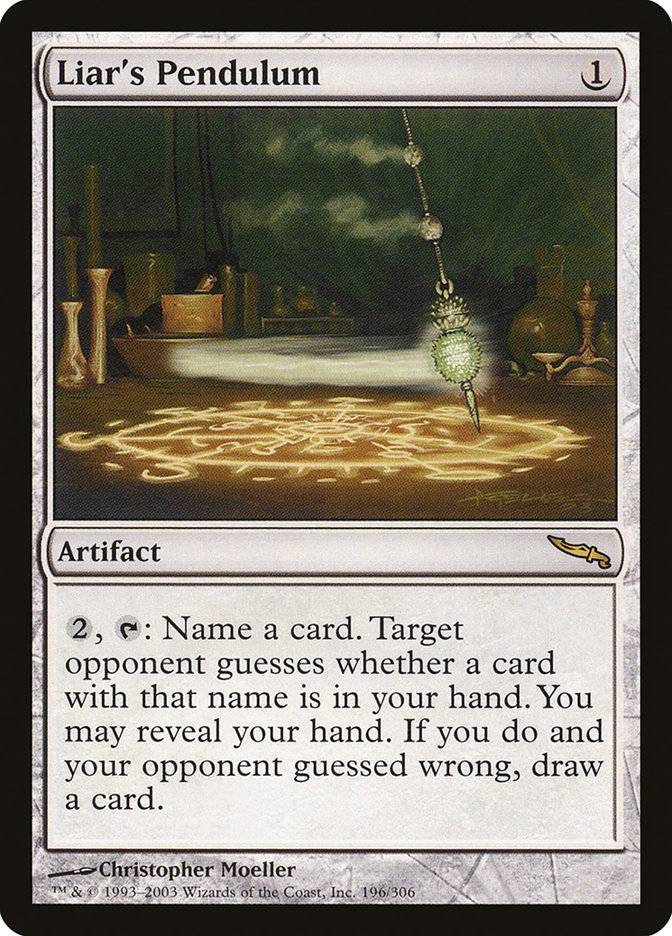I’m no one’s ideal reader.
I’m persnickety. Judgmental. Jealous of my time.
And when I’m reading fiction, I have a bad habit of insisting upon interesting characters and interesting plots.
It’s a wonder I stick with any media franchise at all. Yet Magic, for all its faults, keeps me coming back for more, and two recent Magic Story installments reminded me why.
“The Promised End” is remarkably long by Magic Story standards, over 10,000 words. “Laid to Rest” is significantly shorter, but at 5,000 words or so is no slouch either. “The Promised End” is the conclusion to the Eldritch Moon storyline, while “Laid to Rest” is introduction and re-introduction, the new planeswalker Kaya on the returning plane of Fiora.
I’ll be talking story — two stories, actually — so you might want to read up at the links above before you go on. The rest of this article contains unmarked spoilers in abundance.
All read up? Good. Give Kaya a nod as you step in and let’s get on with it.
The Promised End: Playing on Expectations
On its own, “The Promised End” is a perfectly enjoyable novelette. Three words stood out to me, though. They weren’t in the text itself, but surely they were in the back of Ken Troop’s mind.
“I’ll show them.”
The main storyline thread of Jace Beleren and associates, also known as the Gatewatch, has drawn criticism, some justified and some overblown. (I’ve certainly had my share of critical words for what was then known as Uncharted Realms, but I cringe at the thought of dismissing all of Magic Story with a meme-ified “Ashaya!”)
Ken Troop knew about the reactions. He had to. He’s been one of the strongest Magic Story scribes for a while, writer of the Drana, Liberator of Malakir tale “Memories of Blood” and Noyan Dar, Roil Shaper installment “Shaping an Army” among others.
I refuse to believe that an author of such consistent quality wouldn’t know his audience, their moods, and their reception of Magic’s storyline.
Wouldn’t know the collective disbelief of four new-era (read: weaker) planeswalkers killing a pair of Eldrazi titans in a flash when it took literal decades of work for a trio of old-school planeswalkers to trap them and big sister Emrakul, the Aeons Torn.
Wouldn’t know that the outcome of that battle had been spoiled with cards like Fall of the Titans and Zendikar Resurgent.
Mr. Troop knew how the audience took the Battle for Zendikar block storyline. He knew that the same pattern of “story cards” would show up in Eldritch Moon.
And when all the Internet chatterboxes were yawning and complaining about how predictably things had gone, how Imprisoned in the Moon pointed to yet another easy victory for Magic’s mascots, I imagine Mr. Troop reading their words with an ever-growing grin on his face.
I’ll show them.
And show us he did.
He knew he was writing the last installment of the Eldritch Moon storyline, and that his readers would have seen certain cards pointing to the final outcome. Imprisoned in the Moon is rather blunt, of course, but there’s also Oath of Liliana; it doesn’t make much sense for Liliana to take an oath if the rest of the Gatewatch is dead.
Mr. Troop couldn’t control those facts. What he could control was their interpretation.
Important groundwork was laid in “Memories of Blood,” where Drana’s encounter with a large but not Titan-tier Eldrazi suggested they had thoughts, or the Eldrazi equivalent at any rate. Even earlier, the Magic Origins stories gave the planeswalkers of the Gatewatch more personality than had previously been shown (well, most of them, anyway…ahem, Nissa).
Those were the facts, and the tools. So what did Mr. Troop do with them?
First, he de-emphasized the action. Where “Zendikar’s Last Stand” was largely surface, who was doing what, the core of “The Promised End” was psychological, taking place within Jace Beleren’s head. By shifting the battleground from the plane of Innistrad to Jace’s mind, he made subsequent events unpredictable. (Who saw Jace’s chess game coming?)
Second, he acknowledged past faults. While the planeswalkers of the Gatewatch have a duty as mascots of Magic, they must be able to grow and change if they are to be true characters. Mr. Troop gives us examples of Jace gaining self-awareness and Liliana realizing that her go-it-alone strategy might be suboptimal in certain cases.
Third, he went for broke on the twist and nailed it. Handled poorly, Emrakul’s “I meant to do that” would’ve been a disaster. But because it was set up properly, both before the story and within the tale itself, the twist became absolutely bone-chilling as the Gatewatch — and the readers — realized they had it all wrong. Emrakul wasn’t trying to wreck anything on Innistrad; she’d gotten the interplanar equivalent of a party invitation, but her sketchy acquaintance Nahiri gave her the wrong address, and when she tried to leave, the Gatewatch tried to kill her, so she got to safety as best she could.
Fourth, Mr. Troop didn’t wrap everything up neatly. “Zendikar’s Last Stand” and its follow-up felt really pat to me: roast two Eldrazi Titans, deal with Ugin, the Spirit Dragon and his drama, and claim victory. “The Promised End” sees events through to their conclusion, but closure is in short supply. Jace knows that Emrakul wasn’t trying to fight them or wreck Innistrad; worse still, Emrakul straight-up manipulated Tamiyo, not only forcing her to open one of her forbidden scrolls but changing the contents to a spell that would make Emrakul safe. Speaking of Tamiyo, her emotional devastation is painful and raw and real in a way few pieces of Magic fiction have made me feel in years.
“The Promised End” is arguably the best piece from the “Magic Story” era of Magic fiction. It, alongside the stunning Fate Reforged tale “Khanfall,” argues for the novelette, rather than the short story or novel, as the ideal length for Magic’s longform storytelling.
Laid to Rest: An Intriguing Planeswalker Makes Her Debut
Before her card in Conspiracy 2: Take the Crown was previewed, readers got their introduction to Kaya, Ghost Assassin through the short story “Laid to Rest.” As a story, it’s solid though not unimpeachable; I get that word repetitions are unavoidable sometimes, but count the number of times “place” pops up in the second paragraph and tell me they’re all necessary.
Yet in that same paragraph, here’s how the author describes Kaya’s beverage: “It was good tea, dark and cold and thick with honey. Not the sort of thing you could buy in a place like this.” Between the look of the tea (dark), its temperature (cold), and the way it must feel on the tongue and taste (thick with honey), it’s marvelously multisensory.
That tea and its presence in the Wasp’s Nest also say a lot about Kaya’s personality: she brought her own drink that she knows she’ll like (and can trust), quite possibly from another plane, and she thinks nothing of spending a few coins so the barkeep will stay away. We don’t really need to be told, as we do later, that Kaya comes from a noble lineage; her choice of beverage is at once aristocratic and low-key.
We also don’t need to be told that Kaya indulges in irony or sarcasm, whichever fits best in the moment. There’s an old saying that history doesn’t repeat itself, but it does rhyme…
Why they named her “Kaya” when we already had Jaya…I’ll never know.
Throughout the story, it’s clear Kaya doesn’t like ghosts. Hates them, in fact. She thinks they need to hurry up and get out of the Living Zone already, and if they won’t listen to reason, she’ll make them pay attention to her magic and her daggers. She’s also knows that not every person on every plane feels the same way.
Just enough to keep her paid and clothed and fed. And indulging in her favorite cold honeyed tea whenever she wants.
After the nature of Kaya’s magic is established — she can go translucent purple, shifting between the realms of living and dead, to pass through walls and stab ghosts and other tricks — the rest is decently predictable. The ghost she’s been paid to assassinate has unfinished business of the sort that ticks Kaya right off, and with a payoff from the future Queen Marchesa in sight, she can drop half her fee for her current job without batting an eye. So Kaya gets her ghost target gone another way: by tricking the kinslayer who hired her into returning to the room where he committed the crime, locking him in, and leaving the ghost and the man to their respective fates.
But in “Laid to Rest,” the plot isn’t as important as introducing Kaya’s character. Notably, Wizards of the Coast hired Monique Jones, a journalist and entertainment expert, to help shape Kaya’s as-yet-unseen origin story and home plane, as well as her personality. Ms. Jones’s lived experience and long practice in examining how characters appear in media helped Kelly Digges and Wizards of the Coast make a first-of-her-kind planeswalker who was richer and truer than the current WotC staff could’ve created otherwise.
Just like Dr. Mel Li’s biomedical engineering background took the autopsy descriptions in “The Drownyard Temple” from the technobabble usually found in such scenes to chilling and precise text, the details provided by Ms. Jones helped elevate Magic’s newest planeswalker from “Kaya, Carefully Made as Bland as Possible So We Don’t Offend People Who’ve Seen Way Too Much Stereotyping Garbage in Books and on Screens” to “Kaya, Ghost Assassin Who’s Already Launched a Bunch of Cosplay Projects.” Heck yeah.
And judging by the Kaladesh credits, creative consultancies aren’t going anywhere.
“Laid to Rest” isn’t just another Magic Story. It’s the first chapter in a new approach, a new era in Magic’s worldbuilding and storytelling.
I can’t wait.


